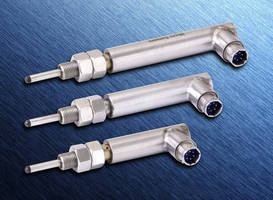Oct 8 2010
The traditional lengthy LVDT position sensing devices' functionality is mainly restricted to industrial pollutants. In order to overcome this issue and to enhance the performance of the sensors, Macro Sensors are presenting right angle LVDT position sensors with a shortened sensing unit that has the ability to evade the contaminants that mount up in the sensing unit.
The LVDTS are configured with a radial electrical connector and are extremely smaller than the axial connectors. The flexible radius of the connecting wires will not increase its length. Thus the integrated length of the LVDT sensors is 2 inch lower than the axial connectors and this feature enables its uncomplicated integration even in compact areas.
 LVDT Position Sensors
LVDT Position Sensors
The radial electrical connector facilitates through-bore functionality which permits the accessibility of the right angle LVDT from the two ends for core guidance and robust mechanical support when compared with the blind-bore systems. The through-bore configuration can also prevent the pollutants from accumulating inside the LVDT unit allowing precise, longer performance. The LVDTs are open at the ends and hence can be easily sterilized of dirt, dust, grit or any other pollutants.
The LVDT operates on temperatures up to 220°F or 105°C. They are enclosed in an air tight manner, made of stainless steel with coil windings for meeting the IEC certified IP-68 standard and can resist 1000psi pressure units. Both the AC and DC designs are accessible and the DC units employ integrated electronics to furnish friction-free dynamic performance by means of DC input and pre-monitored DC output.
Apart from position calibrations in the high-thermal and caustic conditions, it can also be deployed in forges and foundries, metal fabricating machinery, automotive factories, process automation applications, hydraulic cylinder, paper and plastic film plants, saw mills and in most of the motion control units.